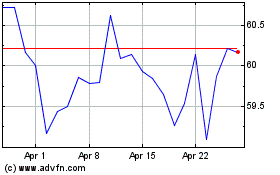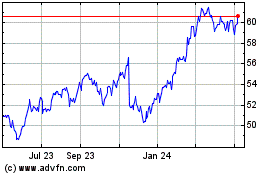Wal-Mart to Adjust Policies on Employee Pay Increases
January 26 2017 - 5:49PM
Dow Jones News
By Sarah Nassauer
Two years after raising minimum wages for store employees to $9
per hour, Wal-Mart Stores Inc. is making adjustments to the way it
hands out pay increases and trains store employees.
The retailer will abbreviate a training program that new
employees must complete to earn $10 per hour. The six-month program
introduced last year will now take three months to complete, said
company executives.
Wal-Mart will stick with an annual raise system it first
implemented last year, in which most store employees get their
raise on a single day. That changes a longtime practice of linking
store employees' annual raises to performance, doling them out on
each employee's hire-date anniversary.
This year employees hired on or before Oct. 31, 2016 will get a
2% raise on Feb. 18th. Longtime workers who make the most their job
title allows get a onetime lump sum of 2% of their annual pay, as
they did last year.
Wal-Mart says its average salary is $13.69 per hour, or about
$25,000 a year for a full-time employee, a pool the company says
makes up just over half of its store workers.
Wal-Mart employs 1.5 million people, both in its stores and in
corporate positions, making it the largest private employer in the
U.S. The evolution of its compensation plan shows what it has
learned about implementing a minimum wage increase on a large
scale.
The moves are an effort to help employees advance faster and
feel more confident in job skills, as well as mollify longtime
employees who see new hires earning wages closer to their own, said
Judith McKenna, chief operating officer of Wal-Mart U.S. Those
improvements will translate into better customer service and store
operations, she said.
Ms. McKenna acknowledged not all longtime employees will be
happy watching pay rise for new workers. "I think it's going to be
an inevitability of businesses," she said. Wal-Mart has worked to
give longtime employees benefits beyond pay, like more paid time
off and encouragement towards promotions to earn more money.
The changes also reflect the difficulty of solving the retail
industry's widespread employee turnover problem in a tightening
labor market. The Bureau of Labor Statistics tracks how many people
leave their job voluntarily monthly. Those numbers have risen
steadily since 2010. The share of retail employees who leave their
job each year hovers around 60%, say industry consultants.
At the same time, service-industry companies, including
Wal-Mart, are fighting for workers. Retail-wage growth has risen
faster than the U.S. average, driven by large retailers' wage
increases and a web of local laws that mandate higher minimum
wages.
"If anything we have seen acceleration in the pace of wage
growth over the last few months," said Andrew Chamberlain, chief
economist at Glassdoor, a jobs and recruiting site.
Last year, Ms. McKenna hosted 59 "listen sessions" with Wal-Mart
store employees around the U.S. to solicit feedback about wages and
training. Managers told her the six-month "Pathways" training
program for new hires needed to be shorter to keep workers engaged.
And employees often said they didn't ask for promotions because
they didn't feel they had been trained well to succeed, says Ms.
McKenna.
Beginning this week, Wal-Mart eliminated a 42-day window between
sessions where workers learn skills on a computer in the back the
room and train with managers on the sales floor.
Retailers will have to continue to find ways to pay for higher
wages to compete for workers, said Pete Madden, a director of
retail at AlixPartners LLP, a consulting firm. "It's going to be an
ever-tricky balancing act," said Mr. Madden. "Passing through wage
increases to customers is the last alternative."
Write to Sarah Nassauer at sarah.nassauer@wsj.com
(END) Dow Jones Newswires
January 26, 2017 17:34 ET (22:34 GMT)
Copyright (c) 2017 Dow Jones & Company, Inc.
Walmart (NYSE:WMT)
Historical Stock Chart
From Mar 2024 to Apr 2024

Walmart (NYSE:WMT)
Historical Stock Chart
From Apr 2023 to Apr 2024
